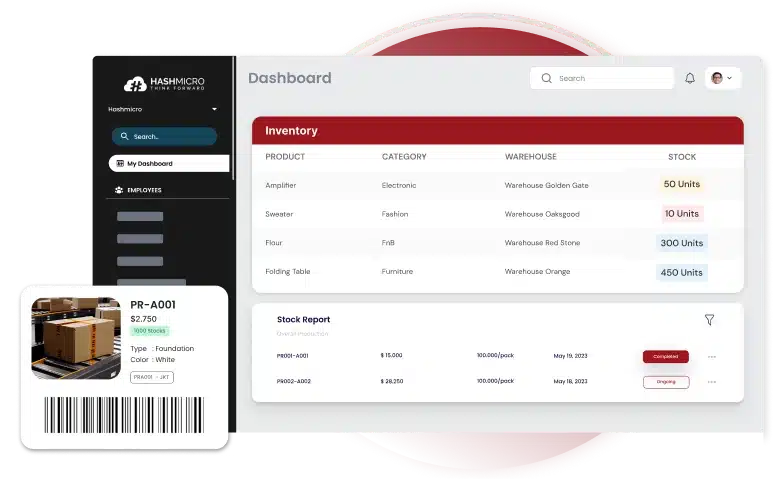Inventory valuation methods play a crucial role in understanding the actual value of my business assets. Since inventory is one of the most valuable components of a retail company’s balance sheet, I need to know its accurate worth.
I can use several methods to determine this value: LIFO, FIFO, FEFO, and Weighted-Average Cost. Each method has its own approach and impact on financial reporting, but manually managing them can be complex and time-consuming. That’s why I rely on inventory software to automate these calculations and ensure accuracy.
Ready to simplify your inventory valuation process? Try HashMicro’s free demo today and experience how automation can make your accounting faster, easier, and more reliable.
Key Takeaways
|
What is Inventory Valuation Method?
Inventory valuation methods are the techniques businesses use to assign value to their inventory and calculate the cost of goods sold (COGS). These methods impact financial statements, taxes, and overall profitability, so choosing the right one is crucial.
An effective inventory valuation method helps me ensure accurate financial reporting and efficient inventory management. It allows me to determine the true cost of my stock, maintain optimal inventory levels, and make smarter pricing decisions.
What are Types of Inventory Valuation Methods?
I use inventory valuation methods to determine my cost of goods sold (COGS) and the value of my ending inventory. Each method affects my financial statements and tax obligations differently, and here are the main types I can choose from:
1. Inventory Valuation: FIFO
The FIFO (First In, First Out) method assumes that the oldest inventory is sold first, while newer stock remains in storage. It’s the most widely used method for inventory valuation, though actual inventory flow may differ in practice.
For example, if a bakery produces 200 loaves at $1.5 and another 200 at $2, selling 200 loaves means the COGS is based on $1.5 per loaf. The remaining $2 loaves are recorded as ending inventory on the balance sheet.
Also read: 5 Effective Ways for Optimizing Inventory Turnover
2. Inventory Valuation: LIFO
The LIFO (Last In, First Out) method assumes that the most recently purchased or produced items are sold first, while older stock remains in inventory. It can reduce taxable income during inflation, but is more complex and costly to maintain.
However, the IFRS no longer allows LIFO because it doesn’t reflect current inventory costs and may distort financial statements. This method can also be misused for tax manipulation, making it less reliable for accurate valuation.
Also read: What is PPIC (Production Planning & Inventory Control)?
3. Inventory Valuation: FEFO

The inventory employee usually arranges the product near the front racks or easily accessible spots so customers can take it promptly. The company will usually store products with a longer shelf life in the warehouse first.
Also read: Why Business Should Switch to Cloud Inventory Management
4. Weighted-Average Cost
The Weighted-Average Cost method combines elements of FIFO and LIFO by dividing the total cost of goods available for sale by the total units. It’s ideal for businesses with identical or blended products where tracking individual costs isn’t practical.
This method simplifies inventory tracking but can be less accurate when prices fluctuate significantly. Businesses may struggle to recover higher costs if selling prices don’t align with rising inventory expenses.
Why is Inventory Valuation Important?
Understanding the importance of inventory valuation helps me see how it impacts every aspect of financial management. Accurate valuation not only ensures proper reporting but also guides better business decisions.
Here’s why inventory valuation is crucial for every business:
- Affects financial statements: It determines the value of assets on the balance sheet and directly influences profit margins and net income.
- Supports pricing decisions: Knowing the actual cost of goods helps in setting competitive yet profitable prices.
- Ensures tax accuracy: Proper valuation prevents overstatement or understatement of taxable income, ensuring compliance with tax regulations.
- Improves inventory control: It helps identify stock inefficiencies, slow-moving items, and opportunities to optimize inventory levels.
- Enhances investor confidence: Transparent and consistent valuation builds trust with stakeholders and reflects reliable financial health.
Challenges of Inventory Valuation
Understanding the challenges of inventory valuation helps me see that it’s more than just tracking numbers. It requires precise cost calculations and consistent monitoring to ensure my business reports accurate financial data.
Here are the main challenges I often face in valuing inventory:
- Determining total inventory cost: Calculating the actual value of inventory isn’t always straightforward, as factors like damage, obsolescence, or changing consumer demand can affect pricing.
- Accurate inventory counting: Measuring how much stock I actually have can be tricky, especially when dealing with goods in transit or relying on manual counts.
- Handling complex costing equations: Although the formula for ending inventory seems simple, applying it accurately requires careful consideration of real-world variables that impact COGS.
- Choosing the right system: Deciding between a periodic or perpetual inventory system influences accuracy; real-time tracking in a perpetual system usually provides more reliable data.
How to Choose the Right Inventory Valuation Method for Your Business
Inventory valuation is a crucial part of my financial management because it directly affects my cost of goods sold (COGS), net income, and tax obligations. With several methods to choose from, I need to carefully evaluate my business model, financial goals, and industry standards before deciding which one fits best.
- Pricing Trends: FIFO shows higher profits when costs rise, while LIFO reduces taxable income.
- Financial Reporting Standards: IFRS prohibits LIFO, so businesses following international guidelines must choose FIFO, WAC, or Specific Identification.
- Industry Practices: Different industries often have standard approaches to inventory valuation.
- Operational Simplicity: FIFO and WAC are easier to manage and align well with high-volume businesses.
Ultimately, the right inventory valuation method balances accuracy, compliance, and financial strategy. By understanding how each method impacts your financial statements and tax obligations, you can make a more informed decision that supports your business’s long-term success.
Optimize Inventory Valuation Process with HashMicro Inventory Management Software

Calculating my stock values requires precision because even a slight miscalculation can harm my business. That’s why I use an inventory management system that automates valuation and accurately tracks inventory using FIFO, FEFO, and Average Cost methods within a periodic inventory system.
I enhance my inventory valuation process with HashMicro Inventory Management Software, which seamlessly integrates with advanced warehouse drone technology. This integration helps me ensure accurate inventory tracking and real-time data updates directly into my system, minimizing discrepancies and improving stock valuation.
Moreover, HashMicro WMS paired with warehouse drones enhances decision-making and financial planning. By leveraging cloud-based inventory management, the system seamlessly integrates drone data to provide precise inventory valuation, helping businesses choose the most suitable valuation methods like FIFO, LIFO, or Weighted Average Cost (WAC). This leads to more accurate financial reporting, optimized forecasting, and reduced operational costs, keeping your business competitive in a fast-evolving industry.
If you want to explore how our system can streamline your inventory valuation, you can register for a free demo now!
Conclusion
The LIFO, FIFO, FEFO, and Average Cost methods are common for an accountant. Accountants often use this method to determine and manage the sales system in the company. However, this method is complex and takes a lot of time to work on. This is what makes an accountant need integrated accounting software from HashMicro.
Moreover, I can adopt an ERP system that integrates all my business functions, automates financial reporting, and generates comprehensive business and inventory reports in real time. If I want to explore how it works, I can request a free demo of the product today!

FAQ About Inventory Valuation
-
What is inventory valuation?
Inventory valuation refers to the accounting process used by businesses to determine the value of unsold goods at the end of an accounting period. This practice ensures that financial statements accurately reflect the company’s assets and cost of goods.
-
How is inventory valuation calculated?
To calculate inventory valuation, multiply the quantity of items in stock by their unit cost. According to GAAP principles, companies must record inventory using the lower of cost or market value, ensuring that financial reporting remains conservative and accurate.
-
How to choose the right inventory valuation method?
Choosing the right inventory valuation method depends on your business needs. For calculating the Cost of Goods Sold (COGS), both FIFO (First-In, First-Out) and WAC (Weighted Average Cost) are commonly used. FIFO is ideal for perishable goods, while WAC is better suited for determining the overall value of total inventory.














